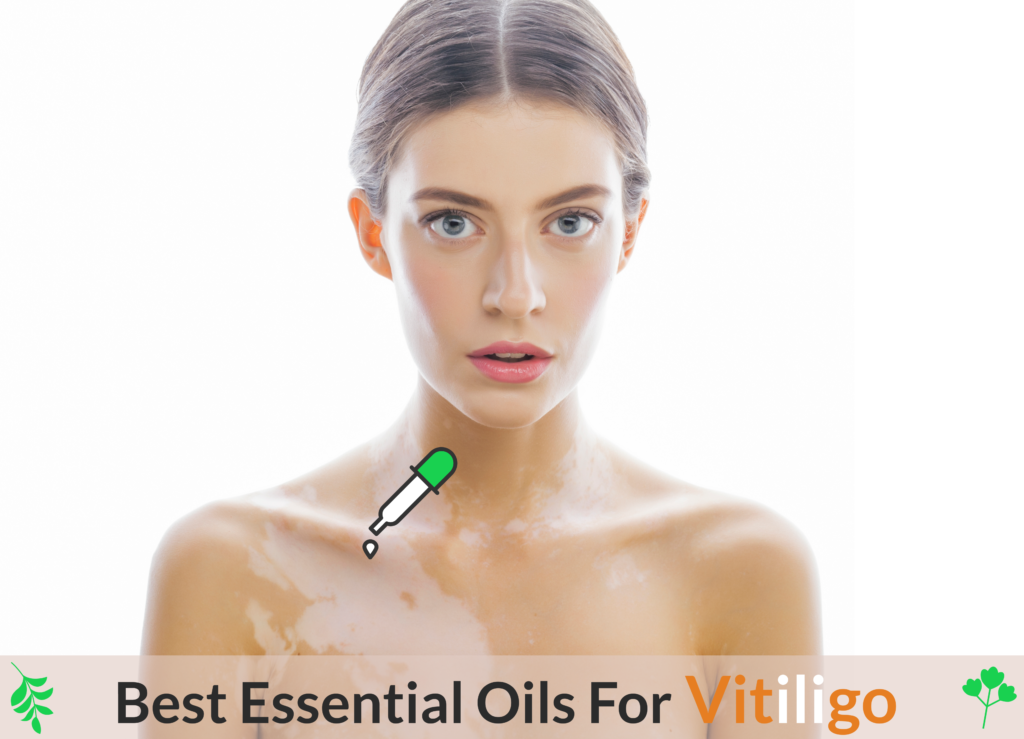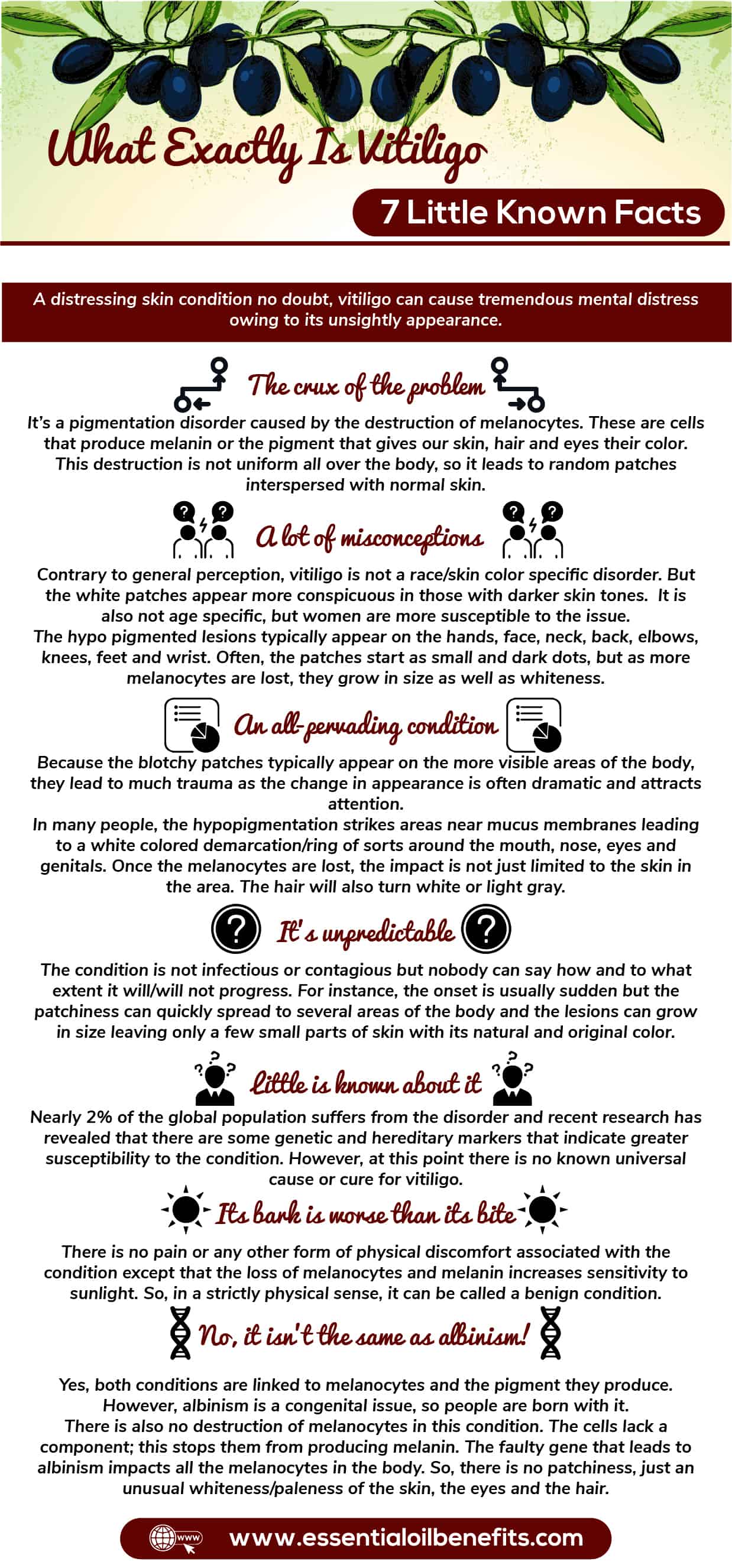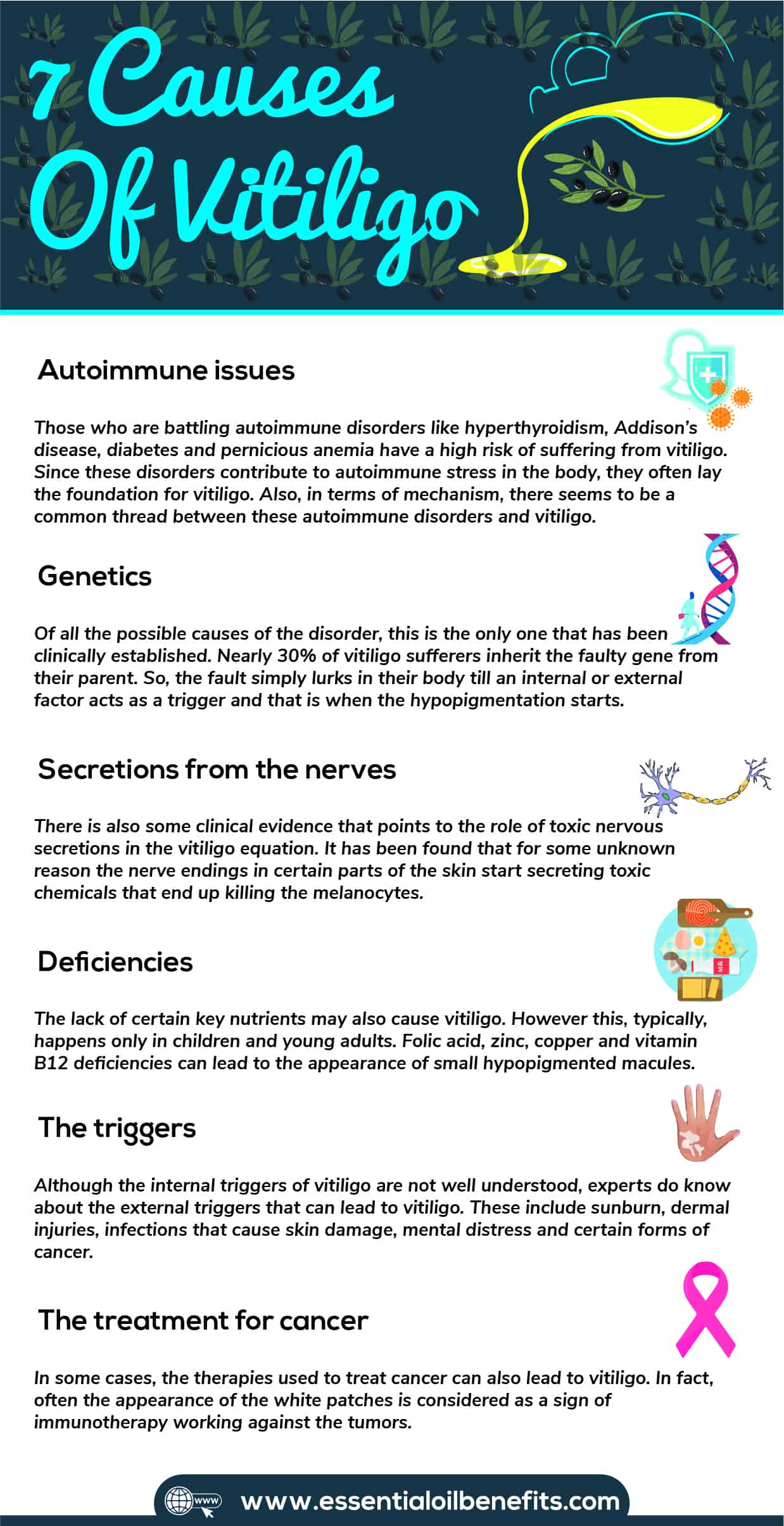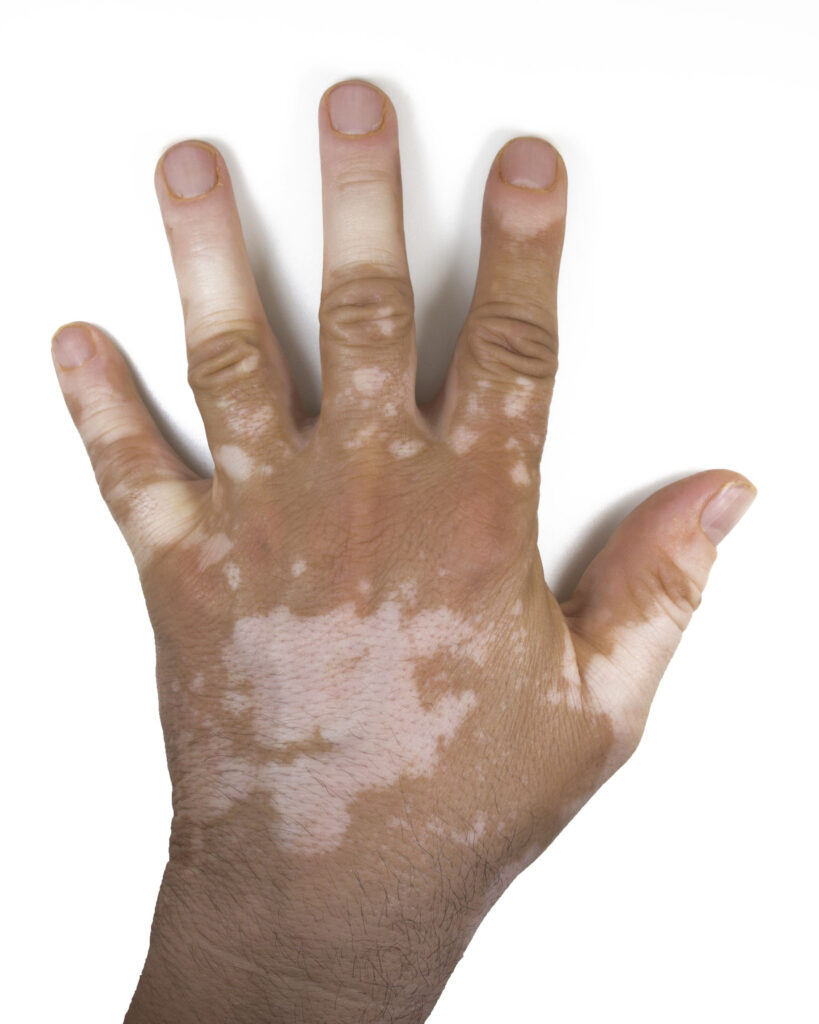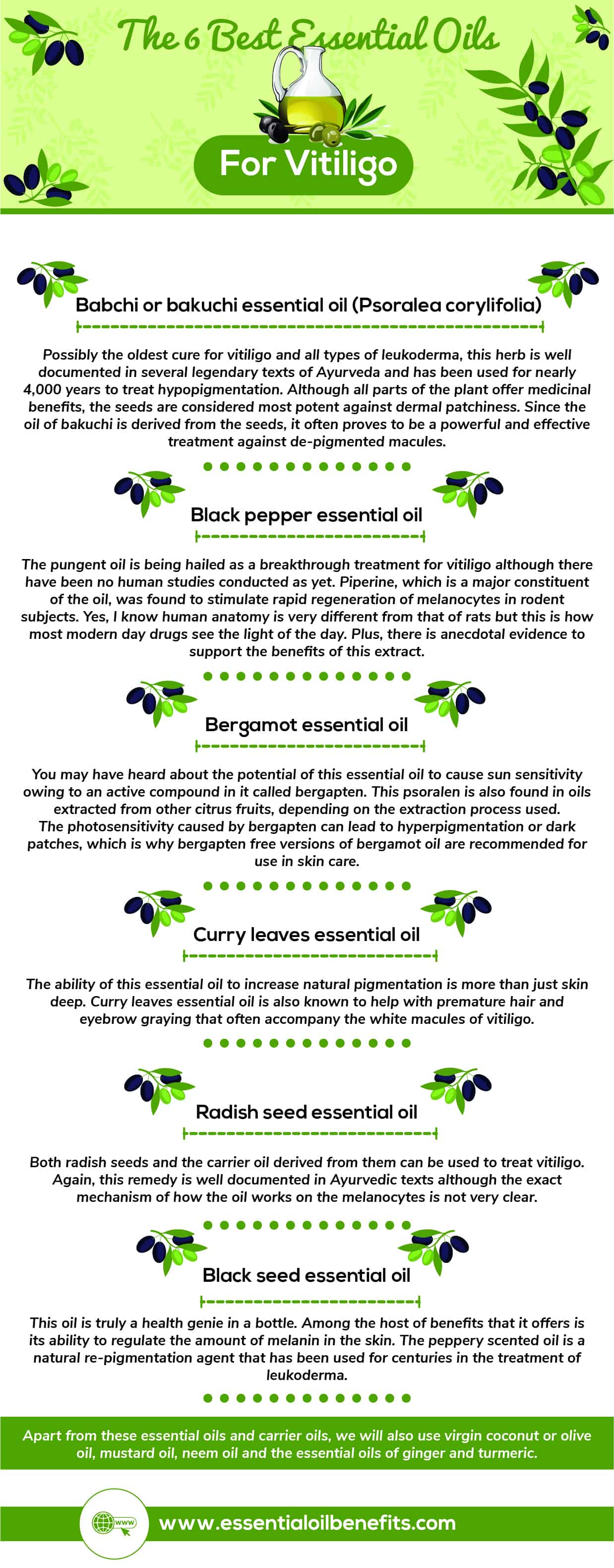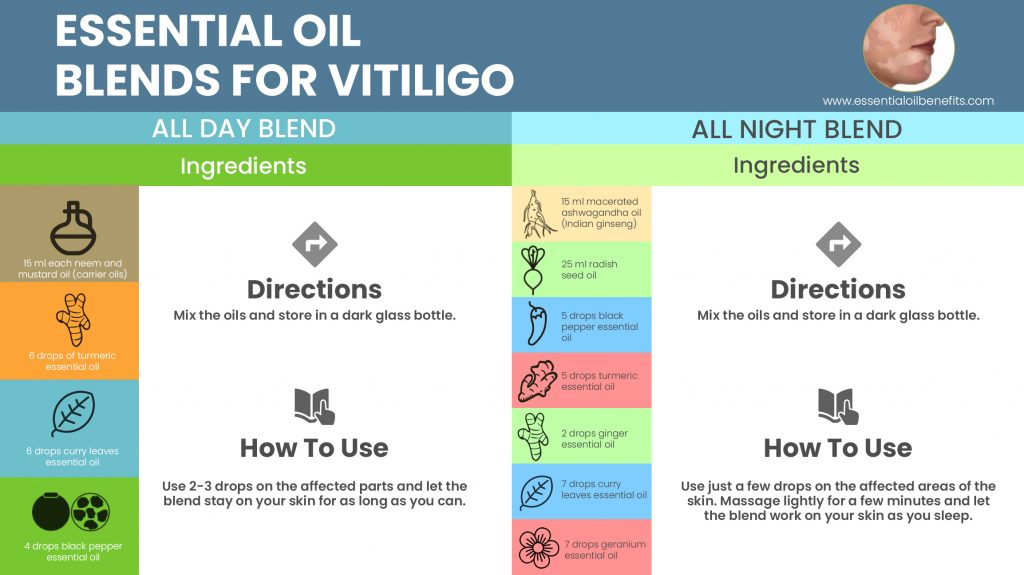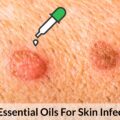This condition was made famous by none other than Michael Jackson, who spent his life claiming that his washed out, ashen white look was attributed to vitiligo and not to a cosmetic, skin bleaching procedure.
It is only upon his death that the autopsy report was able to confirm the truth in his words. More recently, Winnie Harlow’s participation in America’s Next Top Model, put vitiligo in the spotlight once again.
For a condition that causes no physical discomfort nor is dangerous in any sense of the word, vitiligo can wreak utter devastation in the lives of those who suffer from it.
It strikes out of nowhere and there is no telling how far it will spread on the body. The worst part is that once this pesky disorder pays you a visit, it can be extremely hard to kick it out of your life.
Vitiligo remains shrouded in both mystery and myth, with many religious texts describing the ailment as a curse or retribution for wrongdoing.
The Western world may not subscribe to these views, but the social stigma that surrounds this all too visible condition even today is no different from what it was 3,000 years ago.
Unfortunately, vitiligo is still not well understood, which means that modern medicine has limited treatment options for the condition. This begs the question, can Mother Nature actually help to push out the troubling patchiness from your life?
The answers to this and other questions are coming up in this segment for you!
Hello there everybody. I am so glad to have you back for another session of “Naturally Healthy and Happy You”. I am Olivia and you already know that our topic for the day is vitiligo. So, as usual, let us start by discussing the ailment!
What Exactly Is Vitiligo – 7 Little Known Facts
A distressing skin condition no doubt, vitiligo can cause tremendous mental distress owing to its unsightly appearance. In fact, it is not unusual for people who suffer from the condition to go to great lengths to hide their patchy appearance.
Think the garish makeup that MJ would sport, which was meant to camouflage the harlequinesque look of the ailment. A type of leukoderma or hypopigmentation, vitiligo leads to the appearance of irregular white patches on the body. Here is some more information about the condition:
1. The crux of the problem
It’s a pigmentation disorder caused by the destruction of melanocytes. These are cells that produce melanin or the pigment that gives our skin, hair and eyes their color. This destruction is not uniform all over the body, so it leads to random patches interspersed with normal skin.
2. A lot of misconceptions
Contrary to general perception, vitiligo is not a race/skin color specific disorder. But the white patches appear more conspicuous in those with darker skin tones. It is also not age specific, but women are more susceptible to the issue.
The hypo pigmented lesions typically appear on the hands, face, neck, back, elbows, knees, feet and wrist. Often, the patches start as small and dark dots, but as more melanocytes are lost, they grow in size as well as whiteness.
3. An all-pervading condition
Because the blotchy patches typically appear on the more visible areas of the body, they lead to much trauma as the change in appearance is often dramatic and attracts attention.
In many people, the hypopigmentation strikes areas near mucus membranes leading to a white colored demarcation/ring of sorts around the mouth, nose, eyes and genitals. Once the melanocytes are lost, the impact is not just limited to the skin in the area. The hair will also turn white or light gray.
4. It’s unpredictable
The condition is not infectious or contagious but nobody can say how and to what extent it will/will not progress. For instance, the onset is usually sudden but the patchiness can quickly spread to several areas of the body and the lesions can grow in size leaving only a few small parts of skin with its natural and original color.
5. Little is known about it
Nearly 2% of the global population suffers from the disorder and recent research has revealed that there are some genetic and hereditary markers that indicate greater susceptibility to the condition. However, at this point there is no known universal cause or cure for vitiligo.
6. Its bark is worse than its bite
There is no pain or any other form of physical discomfort associated with the condition except that the loss of melanocytes and melanin increases sensitivity to sunlight. So, in a strictly physical sense, it can be called a benign condition.
However, the same cannot be said when you consider the psychological impact of the disfiguring disorder. Vitiligo, understandably, leads to self-consciousness, loss of self-worth, low confidence, emotional distress, depression and anxiety.
In fact, people who suffer from the condition often shun social life or any activity that requires them to step out of their homes just to avoid the inevitable stares.
7. No, it isn’t the same as albinism!
Yes, both conditions are linked to melanocytes and the pigment they produce. However, albinism is a congenital issue, so people are born with it. There is also no destruction of melanocytes in this condition. The cells lack a component; this stops them from producing melanin.
The faulty gene that leads to albinism impacts all the melanocytes in the body. So, there is no patchiness, just an unusual whiteness/paleness of the skin, the eyes and the hair.
In contrast, vitiligo may have a genetic/hereditary link. But, it lurks in your body without producing any ill-effects till it’s triggered usually by a stressful physical or mental event or even a physical illness or any other internal insult (not well understood).
The melanocytes get destroyed gradually in vitiligo. So, it’s a progressive disease, which leads to the patchiness. The resultant white blotches may/may not cover all the skin. Another crucial difference is that while albinism cannot be treated, there is some hope for vitiligo.
3 Types Of Vitiligo
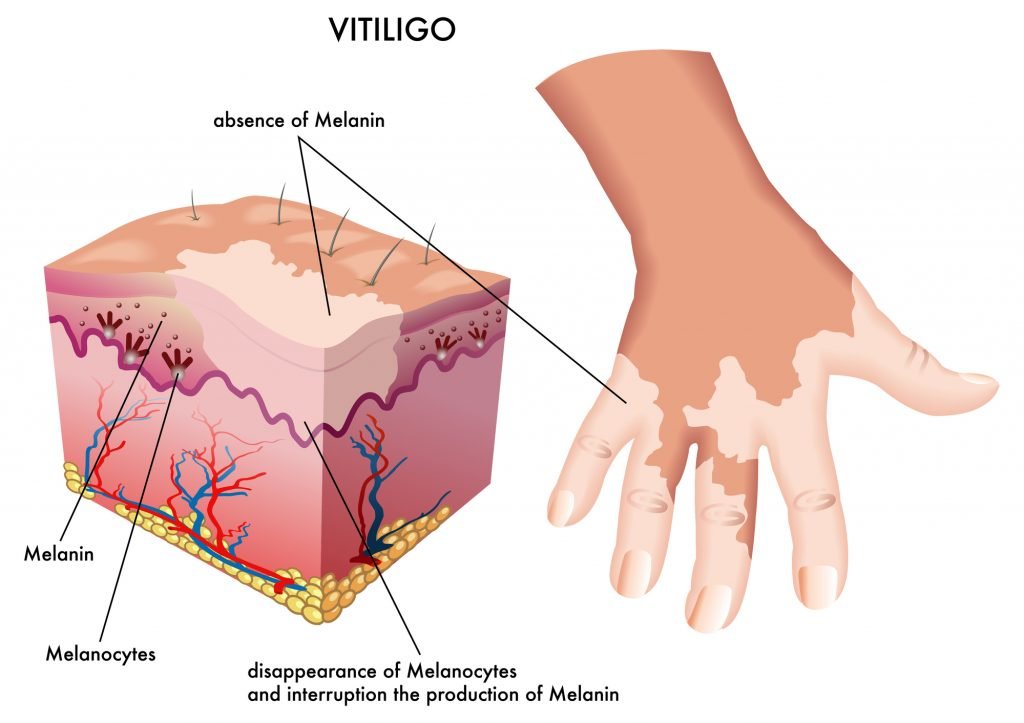
Depending on where the patches appear and their progression, the condition is classified into three types:
1. Non segmental (NS)
Almost 90% of the people, who suffer from vitiligo, have this form of the condition. It progresses slowly, and at least in the initial phases, there is some degree of symmetry in the appearance of the patches.
For instance, if the first depigmented macule appears on the right wrist, the second will appear on the left wrist, round about in the same spot although it may be of a different size.
This type of vitiligo is harder to treat and does not respond too well to topical treatments. Typically, in NS the hypopigmentation starts on areas of the body that are exposed to sunlight such as the hands, face and the neck.
NS leads to patches on the back of the hands, arms, elbows, armpits, groin, knees, feet, around the navel, around the mouth, around the nose and in the genital and rectal area.
The condition can also impact the mucus membranes. In case of mucosal NS, the white patches appear around the lips or the nose and even inside the mouth or the nostrils. Both autoimmune stress and oxidative stress are considered to play a role in the development of NS vitiligo.
2. Segmental (SV)
Also known as asymmetrical vitiligo, this form of the condition is comparatively rare, with just 10% of all vertigo patients suffering from it.
The progression is quick in case of segmental vitiligo, but it responds well to topical and other forms of treatment. Plus, it is less erratic than NS.
Typically, the patches are limited to a specific area of the body and they start as small dots. But the macules can grow rapidly in terms of size and number to form one large patch.
However, in some cases, several hyper pigmented dots appear on a certain part of the body but do not grow in size nor is there further appearance of more depigmented macules.
Segmental vitiligo is more common in children and the spots show up on parts of the body that are served by the nerves arising from the posterior root of the spine. This form of the condition is believed to be a result of dysregulation of the nervous system.
3. Mixed vitiligo
There can also be overlapping of both segmental and non-segmental vitiligo in a person. This is known as mixed vitiligo.
What Are The Symptoms Of Vitiligo!
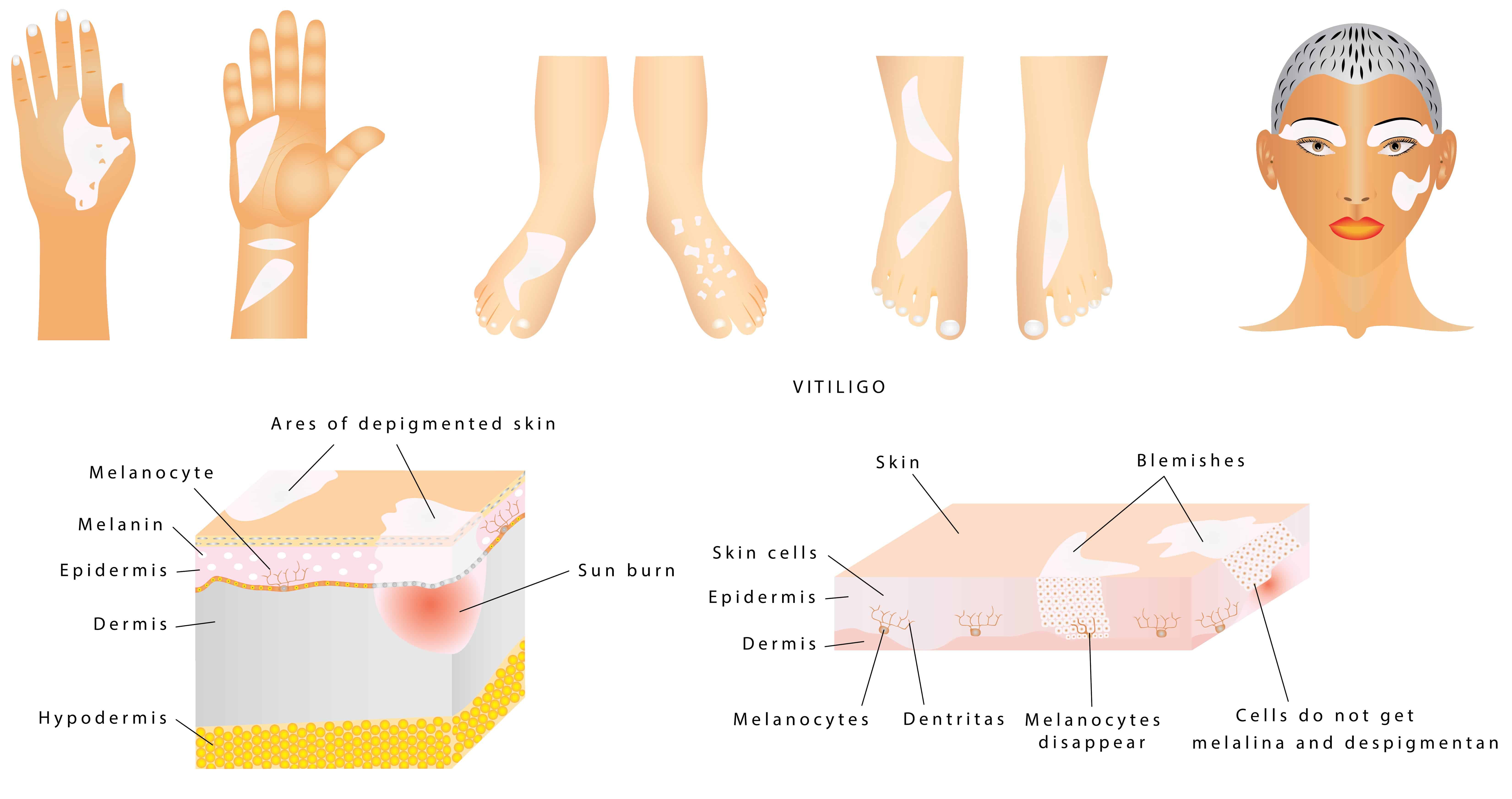
This is one condition that is hard to miss once the macules grow beyond the size of a dot.
In fact, in dark skinned individuals, even tiny dots are easily visible. However, the depigmentation can go well beyond just the skin. Symptoms can for instance be as follows:
- You may also experience premature graying of the hair on your scalp, eyebrows, beard and even the eye lashes.
- In some patients, the hypopigmentation can start inside the nostrils or the mouth.
- There may also be some changes in the color of the irises of the eyes.
- Depigmented skin will have greater susceptibility to sunburns.
- The patches may grow to cover most of your skin, although complete depigmentation is very rare in vitiligo.
Vitiligo can start at any age. However, NS often appears after the age of 15 years while SV is more common in patients aged 4-8 years. The patches or dots may not be completely white/pale in the beginning but do progress to that as the melanocytes are destroyed.
Vitiligo remains an unpredictable condition. So, nobody can say who is at risk of suffering from it nor can an estimation be made about how the disease will progress.
Although SV can be treated with some success in the early stages, once there is significant loss of color, it is almost impossible to get the original skin tone back.
Do We Know Anything At All About The Causes Of Vitiligo? – 7 Potential Causes
Because modern science has not been able to pinpoint the exact cause/causes of the condition, there are an astounding number of misconceptions about vitiligo. So first, let me start by debunking a few myths about what leads to the onset of this disorder.
No, it has got nothing to do with what you eat and in which combination. This misassumption comes from the East, where it is believed that certain food combinations, like meat/seafood and dairy or pumpkin and milk or onion and milk, cause vitiligo.
Another misconception that thrives is about vitiligo being an infectious and contagious disease, which it isn’t. Everything that we know thus far about the condition points to the following causes:
1. Autoimmune issues
Those who are battling autoimmune disorders like hyperthyroidism, Addison’s disease, diabetes and pernicious anemia have a high risk of suffering from vitiligo.
Since these disorders contribute to autoimmune stress in the body, they often lay the foundation for vitiligo. Also, in terms of mechanism, there seems to be a common thread between these autoimmune disorders and vitiligo.
2. Genetics
Of all the possible causes of the disorder, this is the only one that has been clinically established. Nearly 30% of vitiligo sufferers inherit the faulty gene from their parent.
So, the fault simply lurks in their body till an internal or external factor acts as a trigger and that is when the hypopigmentation starts.
3. Internal oxidative stress
Several studies have also pointed to the combined role of both autoimmune and oxidative stress in the onset and progression of NS vitiligo. When an abnormal number of these toxic radicals accumulate in your system, they start killing the melanocytes and also aid in their detachment from their spot under your skin.
Simply put, autoimmune stress starts the fight against the melanocytes in your body while oxidative stress finishes the fight and the cells.
4. Secretions from the nerves
There is also some clinical evidence that points to the role of toxic nervous secretions in the vitiligo equation. It has been found that for some unknown reason the nerve endings in certain parts of the skin start secreting toxic chemicals that end up killing the melanocytes.
5. Deficiencies
The lack of certain key nutrients may also cause vitiligo. However this, typically, happens only in children and young adults. Folic acid, zinc, copper and vitamin B12 deficiencies can lead to the appearance of small hypopigmented macules.
6. The triggers
Although the internal triggers of vitiligo are not well understood, experts do know about the external triggers that can lead to vitiligo. These include sunburn, dermal injuries, infections that cause skin damage, mental distress and certain forms of cancer.
7. The treatment for cancer
In some cases, the therapies used to treat cancer can also lead to vitiligo. In fact, often the appearance of the white patches is considered as a sign of immunotherapy working against the tumors.
Should You See A Doctor For Those White Patches?
Yes, you should because there is some likelihood that a deficiency may be the cause of the white patches.
Given how hard it can be to treat this condition once it progresses, it sure is worthwhile to start treating it as soon as you see the first milky white dot/dots on your skin. And if this means supplementing to tackle the deficiencies, why not?
Also, because an autoimmune issue may be the culprit, it would certainly help to catch that in the early phases as well. So, see a doctor about the macules to rule out both the dangerous and the not so dangerous stuff.
What Are The Treatment Options For Vitiligo?
After a few blood tests, if the doctor finds that the white macules are a result of a nutritional deficiency, you will simply get yourself a prescription for some supplements. If an autoimmune disorder is found to be the cause, the physician will start treating it. However, if these treatment options fail to help, this is what you are looking at next:
Topical treatments
These take on two forms and are usually tried in case of segmental vitiligo. The first line is almost always corticosteroid creams, which work best when used immediately after the initial diagnosis. However, it can be months or even a year before these offer results, if at all. There are also a few side effects that have to be considered before using this form of treatment.
When used over the long term, meaning a few months to a year, they may cause some amount of skin thinning. Sometimes, these ointments also cause red lines and streaks to appear on the skin and these may become a permanent feature.
If corticosteroid ointments cannot be used or have proved to be ineffective, pimecrolimus or tacrolimus ointments are prescribed next. These are immunosuppressive agents that inhibit the release of inflammatory cytokines.
Originally formulated to treat atopic dermatitis, these ointments have found marginal success in dealing with vitiligo. However, these preparations only work when the areas of depigmentation are small.
Although their manufacturers claim that these ointments have fewer side effects than corticosteroid products, the FDA has issued a clear warning about these products, recommending that they only be used when all other forms of treatment fail because they have been linked to skin cancer and lymphoma.
Light therapy
Known as PUVA therapy, this form of treatment combines oral medication with UVA exposure. Although originally recommended for psoriasis, this form of treatment is now often prescribed for vitiligo. Usually, it takes several sessions that have to be spaced out over a period of a couple of months to see visible results.
In fact, very often patients have to go through as many as 3 sessions every week for one year to see a marked change in the white patches. Safety is, once again, a concern here since exposure to UVA rays is a known cause of skin cancer.
Even out the skin tone
When the white macules cover significant areas of the body, doctors often recommend the use of de-pigmenting agents on the unaffected, darker parts of the skin.
These agents lighten the skin tone of the unaffected parts and even out the skin color, at least to some extent. Depending on the extent of unaffected skin, it may take nearly a year to de-pigment all the darker patches.
The treatment has to be done once or twice day and the results are permanent. But the problem is that the complete loss of melanin all over the body means extreme sensitivity to sun exposure.
Also, many patients are not satisfied with the results of the treatment because although the darker areas can be lightened significantly, it may not be possible to completely even out the skin tone.
Masking the patchiness
Special makeup products are now available to conceal the white patches. These are waterproof and specifically designed for use against the disfigurement caused by vitiligo. Although they last way longer than regular cosmetics, some up to 5 days after one application, these are just a temporary solution.
Surgery
When all other forms of treatment have failed, surgical procedures may be considered as an option. Most of these procedures involve grafting healthy melanocytes in the affected parts.
These cells can either be taken through pinch or split thickness grafts from the unaffected parts of the patients own body or they can be harvested and grown externally and then grafted in the affected parts.
The problem with these surgeries, apart from the regular risks associated with surgical procedures of any kind, is that they may result in permanent scarring, which is bound to be darker than the affected parts.
Depending on the type of grafting done, the patient may end up with a cobbled appearance with the dark patches standing out in terms of color and level.
Plus, there is always the risk of infection regardless of how small the surgery is. But, worst of all, the trauma of the procedure can lead to faster and more aggressive growth of the white patches.
Janus kinase inhibitors
Although these are not categorized as immunosuppressants that is what they eventually do by controlling the enzymes, which impact the lymphocytes. These drugs are currently being used to treat certain autoimmune, inflammatory and bone marrow disorders. But, large scale clinical trials have to be conducted to ascertain their safety and for them to get an FDA approval.
Can Essential Oils Really Help To Get Rid Of The White Patches?
Folks, I do not mince my words and I don’t sugar coat things when it comes to discussing the efficacy of a treatment modality, even if the products in question are my favorite essential oils. I firmly believe that the last thing a person, who is battling or living with a health issue, needs is false hope and the imminent disappointment that follows.
So, I am going to lay out my cards on the table here. Is there a guarantee that essential oils will help? NO!
Am I making any claims, even in the remotest sense, that with essential oils you will be able to get your old skin color back completely; that things will go back to being as they were before vitiligo raised its ugly head? Hell NO!
Yes, I heard you asking, then why bother with essential oils? Well, for starters there is a lot of anecdotal evidence and the words from naturopathic texts, some of which date back to several centuries, which back natural options as a treatment and a possible cure for vitiligo.
Herbs, essential oils and all other treatment options recommended here are 100% safe, which means that you will not have to worry about side effects. Because these methods are non-invasive, you won’t have to subject yourself to the risks and trauma of surgical interventions.
But most of all, you will notice that what we know about this condition tells us that oxidative stress, an imbalance of the nervous system and the malfunctioning of the autoimmune system is what leads to the eventual destruction of the melanocytes.
Now guess what? Few other substances in nature and those that are whipped up in labs can compete with essential oils when it comes to their antioxidant powers.
Plus, we already know that these oils have superlative healing and calming potential and that these volatile extracts help to restore balance in the body. Put all of these benefits together and it is not hard to see why and how so many vitiligo patients have had very positive experiences with essential oil blends.
So, if you are all set to give these volatile extracts a chance, let me tell you about some of the most effective oils and how you can use them.
The 6 Best Essential Oils For Vitiligo
1. Babchi or bakuchi (Psoralea corylifolia)
Possibly the oldest cure for vitiligo and all types of leukoderma, this herb is well documented in several legendary texts of Ayurveda and has been used for nearly 4,000 years to treat hypopigmentation.
Although all parts of the plant offer medicinal benefits, the seeds are considered most potent against dermal patchiness. Since the oil of bakuchi is derived from the seeds, it often proves to be a powerful and effective treatment against de-pigmented macules.
2. Black pepper
The pungent oil is being hailed as a breakthrough treatment for vitiligo although there have been no human studies conducted as yet. Piperine, which is a major constituent of the oil, was found to stimulate rapid regeneration of melanocytes in rodent subjects.
Yes, I know human anatomy is very different from that of rats but this is how most modern day drugs see the light of the day. Plus, there is anecdotal evidence to support the benefits of this extract.
3. Bergamot
You may have heard about the potential of bergamot essential oil to cause sun sensitivity owing to an active compound in it called bergapten. This psoralen is also found in oils extracted from other citrus fruits, depending on the extraction process used.
The photosensitivity caused by bergapten can lead to hyperpigmentation or dark patches, which is why bergapten free versions of bergamot oil are recommended for use in skincare.
Normally, the risk of hyperpigmentation is an undesired property but not when you are dealing with vitiligo. In fact, the ability of this oil to cause skin darkness can be used to increase the amount of melanin in the skin.
4. Curry leaves
The antioxidant ability of this essential oil to increase natural pigmentation is more than just skin deep. Curry leaves oil is also known to help with premature hair and eyebrow graying that often accompany the white macules of vitiligo.
5. Radish seed oil
Both radish seeds and the carrier oil derived from them can be used to treat vitiligo. Again, this remedy is well documented in Ayurvedic texts although the exact mechanism of how the oil works on the melanocytes is not very clear.
6. Black seed oil
Black seed essential oil is truly a health genie in a bottle. Among the host of benefits that it offers is its ability to regulate the amount of melanin in the skin. The peppery scented oil is a natural re-pigmentation agent that has been used for centuries in the treatment of leukoderma.
Apart from these essential oils and carrier oils, we will also use virgin coconut or olive oil, mustard oil, neem oil and the essential oils of ginger and turmeric.
Top 5 Essential Oil Recipes For Vitiligo
1. Pre sun exposure blend
Ingredients:
- 1 ounce (30ml) virgin coconut/olive oil
- 7 drops each of bakuchi and black seed essential oil
- 3 drop of turmeric essential oil
Method:
Mix the oils and apply generously all over the affected part. Massage gently for about 2-3 minutes but be careful about restricting the use of this blend to the affected parts. If needed, wipe away any stray droplets of the oil that may have trickled down to the unaffected areas of the skin.
The best time to do this is in the morning, preferably around 9-10 am (in summer), when it is sunny but not scorching hot.
Expose the affected and oil-treated skin parts to sunlight for 15 minutes. Let the oil stay on your skin for no less than 2 hours and then if you want, you can simply wash it off with warm water. Don’t use soap immediately after this treatment.
2. All day blend for vitiligo
Ingredients:
- 15 ml each neem and mustard oil (both of these are carrier oils)
- 6 drops of turmeric and curry leaves essential oil
- 4 drops black pepper essential oil
Method:
Mix the oils and store in a dark glass bottle. Use 2-3 drops on the affected parts and let the blend stay on your skin for as long as you can keep it. Before use, do not forget to do a patch test with this blend because it contains black pepper oil.
3. A sun exposure gel
Ingredients:
- 2 tbsp aloe vera gel
- 1 tsp orange/lime rind powder
- 4 drops bergamot essential oil (do not use bergapten free oil)
- 5 drops bakuchi essential oil
Method:
Mix the powders with the aloe gel then add the oils to the mixture. Whisk for a minute and apply in a thin layer on the affected parts.
While the gel is still on your skin, expose the white macules directly to sunlight (instructions as above, morning and evening sunlight preferred) for 15-25 minutes.
Do not forget to use a sunscreen on the unaffected areas of your body or cover them with some cloth. Wash the gel out with warm water.
4. Night time blend for vitiligo
Ingredients:
- 15 ml macerated ashwagandha oil (Indian ginseng)
- 25 ml radish seed oil
- 5 drops black pepper and turmeric essential oil
- 2 drops ginger essential oil
- 7 drops each of curry leaves and geranium essential oil
Method:
Mix the oils together and store in a dark colored glass container. Use just a few drops on the affected areas of the skin. Massage lightly for a few minutes and let the blend work on your skin as you sleep.
5. Blend for sun sensitive skin
As the hypopigmentation increases, patients suffer from significant photosensitivity which can make it impossible to continue with treatment options that require sun exposure. In such a scenario, this recipe can offer help. It’s slow, but it works. You will need:
- 3 tbsp mustard oil
- 1 tsp turmeric powder
- 1 drop frankincense essential oil
- 2 drops ginger essential oil
- 5 drops curry leaf essential oil
Method:
Mix the ingredients together and store in a dark glass bottle. Shake the bottle before each use. Apply a few drops to the affected parts and let the oil mixture remain on your skin for 3-4 hours at the least. You will need to use this blend twice a day for a period of one year to see visible results. Remember to use old clothes and bed sheets when working with this blend because the turmeric in it will cause stains.
Note:
Do not use blends that contain black seed oil, bakuchi oil, black pepper oil, ginger essential oil near the eyes. As far as sun exposure is concerned, start with 10 minutes and work your way up to 15-20 minutes in 5-7 days. Because the hypopigmented areas will be highly sensitive, do a patch test with the blend before using them.
Home Remedies For Vitiligo

Copper water
This is another home remedy that is highly recommended in Ayurveda, not just for vitiligo but for a host of other ailments as well. The best part is that this one is as easy as drinking some water.
All you have to do is store some water, about a glass, overnight in a copper glass or mug. Keep it covered and at room temperature through the night and then drink it the first thing in the morning. This helps to increase the amount of copper in the body, which helps to stimulate the melanocytes.
Supplements
A two year study conducted by a University in Sweden led to the discovery that regular supplementation with folic acid and vitamin B12 helps to stop the progression of vitiligo in many patients. You may also want to include zinc and beta carotene in your mix of daily vitamins.
The right foods
Although food has nothing to do with the onset of vitiligo, a study conducted on Egyptian patients pointed to a weak link between the regular consumption of citrus fruits and hypopigmentation. Of course, there is no need to shun orange juice based on just this one study. But, remember moderation is the key to get the most from what natural goods have to offer.
Yoga and stress relief
Depression, anxiety, anger, irritability can be called the four horsemen of vitiligo. These troublemakers come into the picture before and after vitiligo, so to speak. They often act as triggers that lead to the hypopigmentation and once the patchiness spreads, they turn into the aftermath.
Regardless of how distressing your condition is, and I know this is easy said than done, spend some time practicing yoga, at least a few times a week. The last thing you need is for the stress to throw your body more out of whack than what it already is.
In Conclusion
Apart from the very visible disfigurement caused by vitiligo, patients are most distressed by the amount of time it takes to treat the condition. Most treatment options require 9-12 months to offer visible results. Often, the effect as not as good as expected, which simply heightens the sense of disappointment and the stress.
So, it is quintessential to take care of your mental health while battling this disorder. The stronger you are mentally, the better your body will fare.
Above all, it will help you to remain committed to the treatment option you have chosen and even go for Round 2, if need be. And on that note, here is wishing you all a smooth and even life and skin free of all sorts of patchiness!

